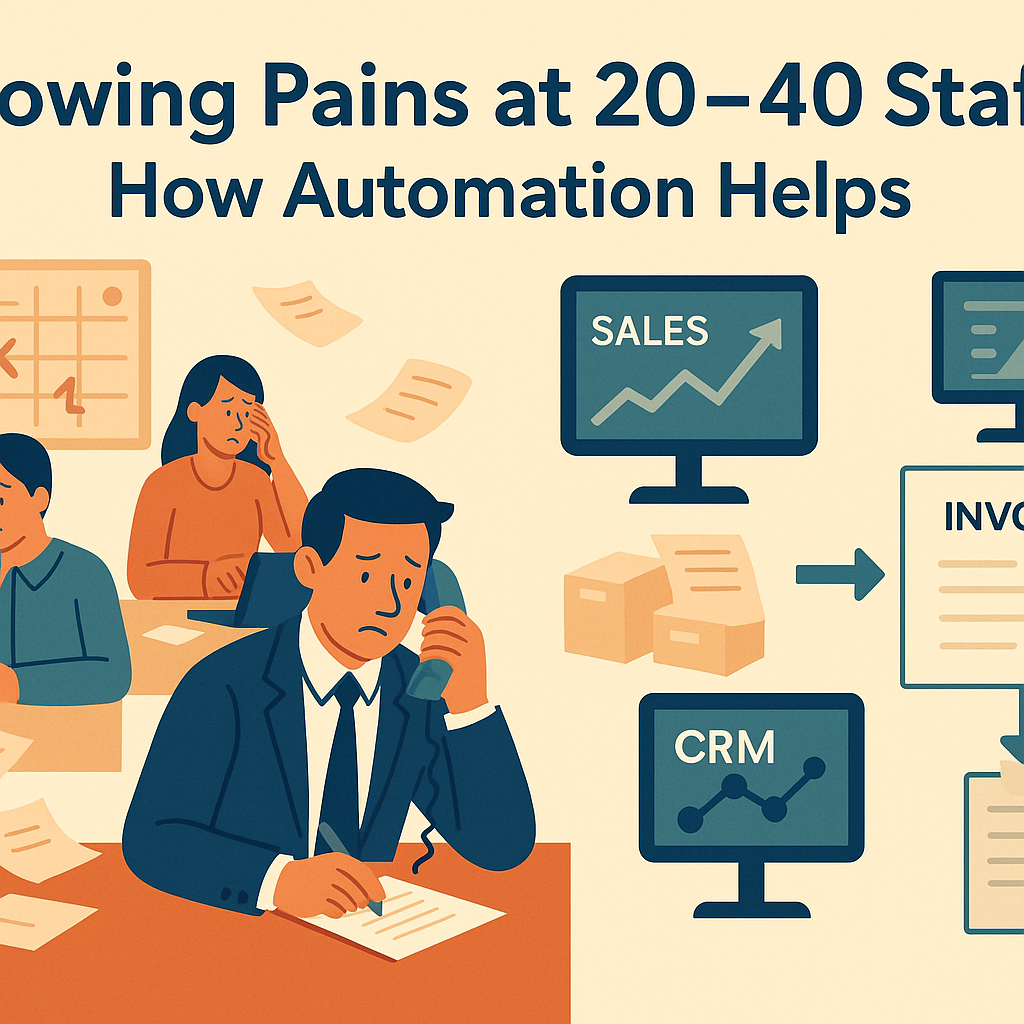For small and medium-sized enterprises (SMEs), the greatest constraint is rarely ambition—it’s time. Staff aFor many businesses, the jump from 10 to 20 staff feels manageable. Everyone still knows what’s happening, processes are flexible, and inefficiencies are absorbed. But somewhere around the 20–40 staff mark, cracks start to show. The business is too big to rely on “what we’ve always done” and too small to afford bloated enterprise systems or armies of administrators.
This is the tipping point where growth often stalls. According to Harvard Business Review, companies hitting this headcount range frequently face complexity creep: duplicated effort, communication breakdowns, and inconsistent processes that erode productivity and margins.
The good news? These growing pains aren’t inevitable. With the right systems and automation in place, mid-market businesses can scale smoothly—competing with enterprises while keeping lean and agile.
The Hidden Costs of Growing Pains
1. Communication Breakdowns
At 20 staff, you can still shout across the room. At 40, that no longer works. Scheduling, rescheduling, job updates, and customer communications start to get lost. A Gartner survey found that miscommunication costs companies an average of $12,506 per employee per year—a huge hit for a mid-market firm.
2. Manual Process Overload
Processes that were fine with a handful of staff—Excel sheets for stock, emails for scheduling, Word docs for compliance—become liabilities. Staff spend hours rekeying data between systems, and errors multiply. What felt efficient at 10 staff becomes chaos at 30.
3. Compliance and Risk Exposure
As teams expand, so does scrutiny. Regulators, auditors, and clients expect tighter processes. Manual compliance tracking is not only risky—it’s slow. PwC estimates automation can cut audit preparation time by up to 50%, freeing teams for revenue-generating work.
4. Customer Experience Decline
Customers notice the cracks before leadership does. Delays in communication, inconsistent service, and missed follow-ups drive churn. Research by Salesforce shows that 76% of customers expect consistent interactions across departments—something mid-sized firms struggle with when systems aren’t integrated.
How Automation Fixes the Growing Pains
Streamlined Quote-to-Invoice Workflows
Instead of staff rekeying quotes into invoices, automated systems generate them instantly when a deal closes. Payments trigger stock allocation, courier bookings, and customer updates. The result: faster cash flow and fewer errors.
Smarter Scheduling and Visibility
Tools like Zoho FSM or integrated calendar systems ensure cross-team visibility, automated rescheduling, and seamless communication. No more missed jobs or clashing appointments.
Data Standardisation
Standardising product codes, bundles, and customer records creates a single source of truth. This eliminates duplication and ensures reporting is accurate—a foundation for advanced analytics and decision-making.
Automated Customer Communications
Pre-built email and SMS templates confirm bookings, send reminders, and share updates automatically. Customers feel informed without staff lifting a finger.
Compliance Made Easy
Automation handles document generation, tracks consent, and ensures processes are auditable. That’s less admin time, fewer risks, and smoother audits.
Real-World Example
One mid-sized construction supplier I worked with faced constant scheduling errors and stock misallocations as they hit 30 staff. Jobs were delayed, customers were frustrated, and staff were exhausted from firefighting.
By introducing a phased automation roadmap, we:
- Standardised data across CRM, Inventory, and Accounts.
- Automated quote-to-invoice workflows.
- Integrated courier tracking directly into customer updates.
- Implemented profitability reporting for each job.
Within six months, scheduling errors dropped by 70%, cash flow improved, and staff had time to focus on growth instead of firefighting.
The Bottom Line
Hitting 20–40 staff is a milestone, but it’s also a danger zone. Businesses at this stage often discover that what worked before no longer scales. Manual processes, poor communication, and inconsistent data become anchors that slow growth.
Automation is the lever that frees mid-market firms from those anchors. By streamlining workflows, standardising data, and improving visibility, businesses can not only survive the 20–40 staff stage but thrive—scaling revenue without scaling chaos.
In short: the sooner you tackle growing pains with automation, the sooner you turn staff from firefighters back into innovators.

